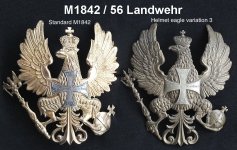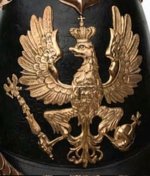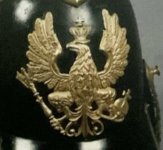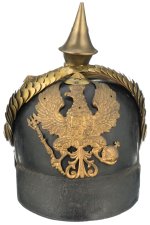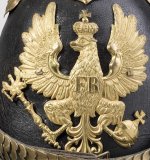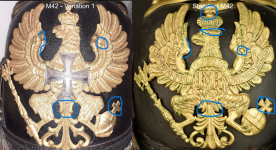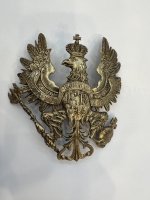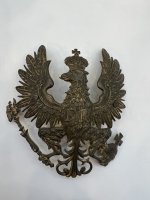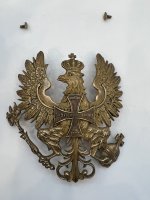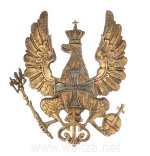Sandmann
Well-known member
Dear fellow collectors,
I‘m currently working on a next Blog entry for my website about the Prussian helmet eagle plates from 1842 to 1918. In this search I came across different helmet eagle variations of the M1842/43 and I wonder if there are more of them?
I have already found the following type of helmet eagles M1842/43. A big thank you to Tony V, Tony Schnurr and philipp-militaria.com for allowing me to use their photos!
Cast helmet eagle M1842/43 for enlisted men and officers:
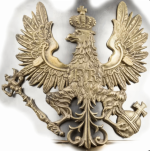
Cast helmet eagle M1842/43 for officers:
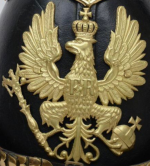
Standard helmet eagle M1842/43 for enlisted men and officers (This one was modificated in 1860 with a soldered banner):
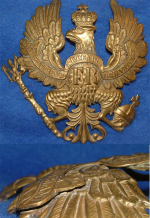
The following variations of the helmet eagles M1842 are all Landwehr eagles. I have no doubts that the helmet eagles originally belong to the helmets, because they differ in some points from the similar looking helmet eagles M1860 or M1871. I think that they were produced shortly before the introduction of the M1860. Since they are exclusively Landwehr eagles and their quality is substantially better than the standard M1842, I guess that they were all emblems for property helmets.
Variation 1 of a helmet eagle M1842/43:
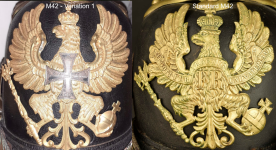

Overlay M42 variation 1 and M60 (aligned to width, which was always about 14cm):
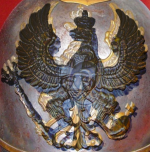
Variation 1A of a helmet eagle M1842/43 for officers:
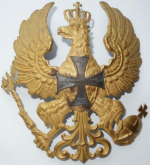
Variation 2 of a helmet eagle M1842/43:
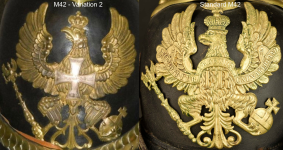
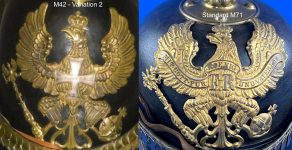
Overlay M42 variation 2 and M71 (aligned to width, which was always about 14cm)
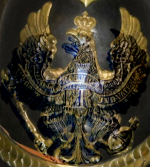
I‘m currently working on a next Blog entry for my website about the Prussian helmet eagle plates from 1842 to 1918. In this search I came across different helmet eagle variations of the M1842/43 and I wonder if there are more of them?
I have already found the following type of helmet eagles M1842/43. A big thank you to Tony V, Tony Schnurr and philipp-militaria.com for allowing me to use their photos!
Cast helmet eagle M1842/43 for enlisted men and officers:

Cast helmet eagle M1842/43 for officers:

Standard helmet eagle M1842/43 for enlisted men and officers (This one was modificated in 1860 with a soldered banner):
- It is 12,5 cm - 13 cm high, has straight upwards directed wings with Schwarzenegger-Biceps, a large head and crown, protruding material between wings and legs and wide swept tail feathers.

The following variations of the helmet eagles M1842 are all Landwehr eagles. I have no doubts that the helmet eagles originally belong to the helmets, because they differ in some points from the similar looking helmet eagles M1860 or M1871. I think that they were produced shortly before the introduction of the M1860. Since they are exclusively Landwehr eagles and their quality is substantially better than the standard M1842, I guess that they were all emblems for property helmets.
Variation 1 of a helmet eagle M1842/43:
- Similarities to M1860: Tail feather roots and missing Schwarzenegger-Biceps.
- Differences to M1860: Larger head and crown, straight upwards directed wings, the eagle is higher than a M1860 and the scepter angle of a M1860 is flatter.


Overlay M42 variation 1 and M60 (aligned to width, which was always about 14cm):

Variation 1A of a helmet eagle M1842/43 for officers:
- Similarities to M1860: Tail feather roots.
- Differences to M1860: Larger head and voided crown (not common for officers until 1860), straight upwards directed wings with smaller Schwarzenegger-Biceps and the 3 leaves at the end of the curved line on the wings are still designed as on the M1842. Later versions were pressed in like shown on the example before. Further the eagle is higher than a M1860, the scepter angle of a M1860 is flatter and the center tail feathers have an additional step at the lower third.

Variation 2 of a helmet eagle M1842/43:
- Similarities to M1871: Tail feather roots, missing Schwarzenegger-Biceps but 3 bumps behind the ellbow.
- Differences to M1871: Straight upwards directed wings, the eagle is much higher than a M1871 and the scepter angle of a M1871 is flatter. The 3 bumps behind the ellbow are larger than these on the M1871. Further the roots of the tail feathers with the pattern "vVv" are narrower than on the M1871 and there are still feathers from the body next to them. On the M1871, the tail feather roots are wider and shorter and the feathers from the body shown next to them, if they are present at all, are much narrower and blend right into the feathers of the legs.


Overlay M42 variation 2 and M71 (aligned to width, which was always about 14cm)

Last edited:

